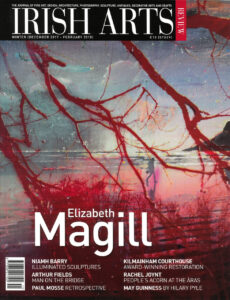

Christian Dupont follows the relationship between art and cultural identity as seen in two works from the collection of Burns Library at Boston College
Following the enactment of the Republic of Ireland Act in December 1948, Minister for External Affairs Seán MacBride appointed a Cultural Relations Committee to advise him on ‘the development of cultural relations with other countries.’ Made up of figures such as Senator EA McGuire and architect Michael Scott, one of their first initiatives was to organize a travelling exhibition of ‘Contemporary Irish Painting.’ It showcased the work of 73 living artists, nearly half of whom were women. Of the 89 paintings selected for display, 81 were labelled for sale, and 53 sold.
Exhibitions in multiple North American cities were envisioned, yet venues in only three were secured for the spring of 1950: Providence (Rhode Island), Boston, and Ottawa. The Boston stop came under threat when the Museum of Fine Arts objected to an exhibition that included pieces with price tags.
To save the face of the city’s prominent Irish, the Eire Society of Boston stepped in. Its officers voted to underwrite costs and drew on their relationship with the Boston Pops Orchestra to have the exhibition installed in Symphony Hall. Organizer Elizabeth Curran of the National College of Art, Dublin, was invited to speak at a monthly meeting of the Society ahead of the opening on 6 May. Curran also gave guided tours throughout the month.
If Pearse envisioned Ireland as not Gaelic merely, but free, the diaspora pictured an Ireland that was not only rural, but revolutionary
Members were urged to see the show and buy its contents, both to help the artists and as a ‘permanent memento’ of the Society’s purpose ‘to spread awareness of Irish Culture.’ President Joseph Gannon acquired for himself four modestly priced paintings by Micheál de B√∫rca, Sylvia Cooke-Collins, Ernest Hayes, and Tom Nisbet.
Others acquired paintings for Boston College, which had lately established a special Irish collection in its college library with support from the Eire Society. In memory of her husband, an alumnus of the Class of 1884, Mrs Francis J Barnes purchased a depiction of Donegal’s Tramore Bay by Frank McElvey.
Mrs Edward C Donnelly, heiress to her husband’s profitable outdoor advertising agency, purchased a Paul Henry landscape of Connemara. Priced at $1,015, it was the most expensive canvas in the exhibition, attesting the emblematic status Henry’s landscapes had achieved through their use in tourism campaigns and previous showings in American galleries. A booklet published by the library deemed it ‘of special interest because one of the thatched cottages shown in the painting was for many years the vacation home of Padraic Pearse.’ A doubtful claim, it nevertheless reflected the prevailing nationalist sentiments of the Boston Irish: if Pearse envisioned Ireland as not Gaelic merely, but free, the diaspora pictured an Ireland that was not only rural, but revolutionary.
Although not a member of the Eire Society, Monsignor Francis Burke acquired, in memory of a younger fellow alumnus and priest Randall Coyne, a portrait that Margaret Clarke had painted of her son-in-law, John Damien Bourke. First displayed in the Royal Hibernian Academy in 1946 under the name of its subject, it was listed in the exhibition catalogue with the symbolic title it has since retained, The Gael.
This is the third in a series of articles on Burns Library and its collections that attempts to provide context for appreciating the work of Irish artists and their reception in America.
Christian Dupont is Burns Librarian and Associate University Librarian for Special Collections at Boston College.



